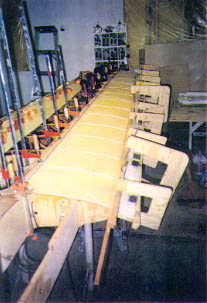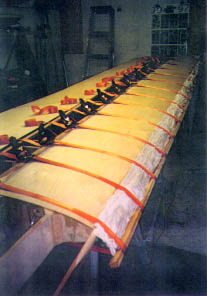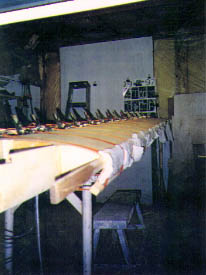Skinning the Wing
![]()
Skinning the Wing |
|
by Gordon Cook
|
This article appeared in the December 1998 issue of Falco Builders Letter. |
I scarfed all the pieces for the top leading edge skins (main spar to the leading edge, and from rib 1 to rib 14) together on the bench being careful to ensure the scarf joints would fall on a wing rib. Putting the scarf joint on a rib probably isn't necessary, but it will probably be more acceptable to the inspector. Doing the scarfing on the bench ensures a perfect joint. You can't feel the joint by running your hand over it.
I did the wing skins in this manner, the top fore and aft of the main spar, the same for the underside of the wing, the tops and undersides of the flap/ailerons and the 1mm fairing aft of the rear spar. If I hadn't yet done the fuselage, I would probably try this method to see if it would work as well there as it has on the wing.

The plywood was oversize by about 6" to 7" on the leading edge to accept a stiffener for the bending operation. I marked the rib and spar positions on the underside and the topside of the plywood, then I glued a piece of wood, 3/4" x 1-1/4" x 11 feet long, to the waste portion of the leading edge for stiffening.
The gluing operation is a two-man job since the pot life of the glue I use is about an hour. My son applied the glue to the ribs and spars (but not the leading edge piece) while I applied it to the plywood (but not where it comes in contact with the leading edge). We didn't spare the glue-I wanted no glue voids, and we accomplished that. However it means crawling under the wing after the gluing is complete to wipe off the excess glue. About 225 ml of glue was sufficient to do the job.
With the skin clamped to the main spar, I then began the stapling operation. This is where the rib and spar locations marked on the top of the skin really pay off. During the stapling operation, I added a strong nylon cord under the staple to provide an easy method of removing the staples.
Note: Keep one hand between the staple being removed and your face. Most staples pop out one side only, but it only takes one to pop out on both sides to staple you. I got it just below the right eye, and it buried itself full depth, 5/16". No real damage, but an inch higher and I could have lost an eye. Ensure there is no thickness of glue at the leading edge of all the ribs.
I used a few deep-throat clamps made from 3/4" fir plywood and 5/16" pre-threaded rods and angle iron placed along the leading edge to bend the skin tight to the top of the leading edge.

When the glue had set and the clamps and staples were removed, I began soaking the part of the skin that takes the radical bend. I used cloth shop towels soaked every few hours with boiling water to thoroughly soak the skin. I placed web clamps wrapped around the main spar and the leading edge of the skin and stiffener at each rib location, then tightened them every few hours during the day and evening until I had the desired bend.
The watch word here is patience. It took about four days of boiling water, steam iron and slowly increasing the tension on the web clamps and another three or four days to ensure the skin was dry before gluing it to the leading edge-2.5mm plywood does not take kindly to bending.
I flipped the wing over and slacked off the web clamps to glue the leading edge. This allows gravity to take the glue to the top of the leading edge strip and ooze out a little. When this happens, you know the glue has completely covered the leading edge. I then retightened the web clamps, waited 24 hours, removed them, cut the stiffening piece off, flipped the wing to a vertical position and feathered the skin to about 1/2 inch below the center line of the leading edge.
After inspection, I'll do the same for the leading edge skin on the underside of the wing. The next operation will then be the top side aft of the main spar.
If I hadn't already placed the 1mm fairing skin aft of the rear spar, I would have scarfed and glued the entire wing skin and placed it on the wing in one operation. But with the fairing skin in place, it was impossible to wrap the web clamp around the rear spar without damage to the fairing.

|
|